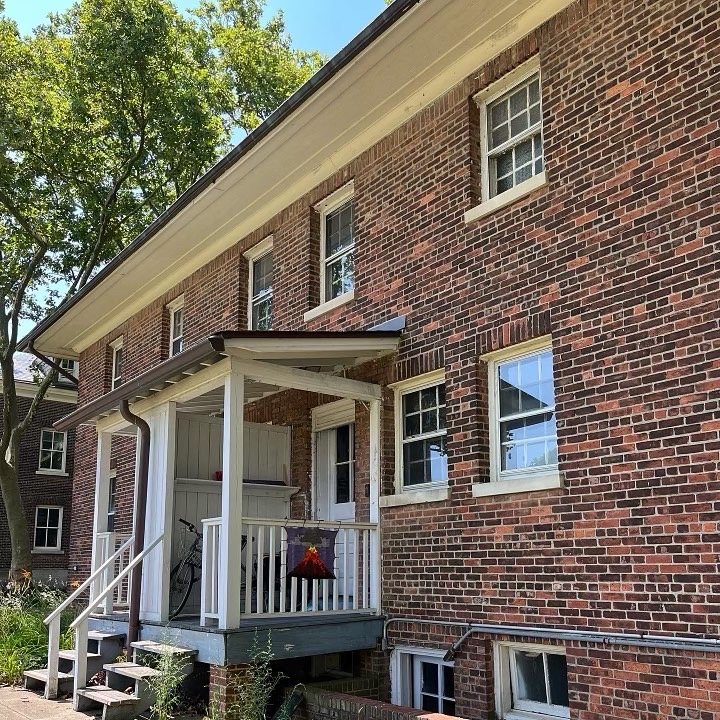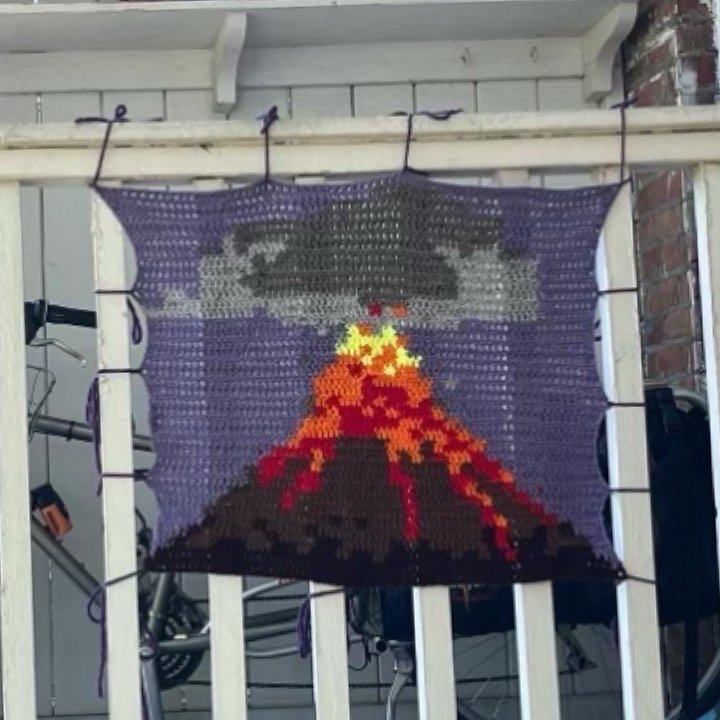Artist talk: Tessa Grundon and Gene Kiegel
Join us on Sunday July 24th, 4pm, at 410A Colonel’s Row. Artists Tessa Grundon and Gene Kiegel will speak about the overlaps and geological connections in their joint show, 'Emergent Strata', which closes on July 31. All are invited and welcome! Bring a picnic blanket or sit on the grass.
Picture a cross-section of earth, layered with the unconformities and fractures of geologic time. In Emergent Strata, Tessa Grundon and Gene Kiegel uncover these layers, their vestiges and sediments, in landscapes: along the contour lines of a riverbank, through the intricate architecture of bees and their waxy walls, and in the negative space of industrial ruins. Colors pour forth from geological folds, seams, and formations; this work allows us to see these compressed worlds, cross-cutting and overlapping the relative time of humans and nonhumans in the earth-record.
Tessa Grundon
is a British artist working on both sides of the Atlantic. Her work is rooted in “place” using elements of the landscape to explore environmental issues. For the last few years she has been based on Governors Island in NYC Harbor working with arts and science organizations including SWALE, Urban Soil Institute, NYU Gallatin’s Wetlab, Works on Water and Underwater New York focusing on engagement with the environment and education. Most recently, she has started working with Artist Space as a teaching artist on the Lower East Side. Other partnerships and residencies include Brooklyn Navy Yard, Art.Earth, I-Park, Wave Hill, PLACE Collective and Sail Britain. She states: "My work is rooted in "place" using materials from the natural and fabricated world reflecting the Anthropocene in which we live. Using elements of the landscape, my work is inspired and influenced by the topography and history of a place and its ever-changing environment. This ranges from the rising and increasingly polluted tides to the effect of humankind on community, climate and landscape, to man himself and the shared visual language of natural forms."
Gene Kiegel
is an interdisciplinary artist currently based in New York. His work challenges our understanding of the universe, exposing an omnipresent universal language through a wide range of innovative and unconventional materials and artistic processes. Born in Odessa, Ukraine, Kiegel immigrated in 1989 as a Jewish refugee to the United States. The shock of loss and relocation impelled Kiegel to channel his emotions into art—what began as an instinctive coping mechanism has evolved into a lifelong practice. Kiegel holds a Bachelor of Arts in Environmental Design & Architecture from the University of California Berkeley (1998). In 2000, Kiegel moved to Los Angeles and began his artistic journey with photography. Analogue photography inspired new art projects, prompting Kiegel to move to New York. Kiegel has exhibited internationally (New York, Miami, Los Angeles, London, Paris, St. Petersburg) with artwork in the collections of Elli Tahari, Tiffany Masterson, Moishe Mana, Moshe Mamrud, Miguel Mendoza, and others.
Sleeping Giants
Join us on July 24th at 5:00pm at 410A Colonel’s Row. Musicians and composers Erica Mancini and Jack Helfrich will present a 30-minute musical performance inspired by volcanoes! All are invited and welcome! Bring a picnic blanket or sit on the grass.
A VOLCANIC YARN BOMB!
Yarn bomb the New York Virtual Volcano Observatory any day through July 21st! Bring your fiber art creations and add them to the back porch of the Virtual Volcano Observatory house, 410A Colonels Row. All are welcome, you don’t need to ask our permission to collaborate with us. Tie them onto existing pieces/the railing and engage with Earth science through a world of fibers
Emergent Strata (2022)
Tessa Grundon + Gene Kiegel
Pop-Up Exhibition, 410A Colonel’s Row, Governors Island
May 21 - July 31, 2022
Picture a cross-section of earth, layered with the unconformities and fractures of geologic time. In Emergent Strata, Tessa Grundon and Gene Kiegel uncover these layers, their vestiges and sediments, in landscapes: along the contour lines of a riverbank, through the intricate architecture of bees and their waxy walls, and in the negative space of industrial ruins. Colors pour forth from geological folds, seams, and formations; this work allows us to see these compressed worlds, cross-cutting and overlapping the relative time of humans and nonhumans in the earth-record.
Tessa Grundon is a British artist working on both sides of the Atlantic. Her work is rooted in “place” using elements of the landscape to explore environmental issues. For the last few years she has been based on Governors Island in NYC Harbor working with arts and science organizations including SWALE, Urban Soil Institute, NYU Gallatin’s Wetlab, Works on Water and Underwater New York focusing on engagement with the environment and education. Most recently, she has started working with Artist Space as a teaching artist on the Lower East Side. Other partnerships and residencies include Brooklyn Navy Yard, Art.Earth, I-Park, Wave Hill, PLACE Collective and Sail Britain. She states: "My work is rooted in "place" using materials from the natural and fabricated world reflecting the Anthropocene in which we live. Using elements of the landscape, my work is inspired and influenced by the topography and history of a place and its ever-changing environment. This ranges from the rising and increasingly polluted tides to the effect of humankind on community, climate and landscape, to man himself and the shared visual language of natural forms."
Gene Kiegel (b.1974) is an interdisciplinary artist currently based in New York. His work challenges our understanding of the universe, exposing an omnipresent universal language through a wide range of innovative and unconventional materials and artistic processes. Born in Odessa, Ukraine, Kiegel immigrated in 1989 as a Jewish refugee to the United States. The shock of loss and relocation impelled Kiegel to channel his emotions into art—what began as an instinctive coping mechanism has evolved into a lifelong practice. Kiegel holds a Bachelor of Arts in Environmental Design & Architecture from the University of California Berkeley (1998). In 2000, Kiegel moved to Los Angeles and began his artistic journey with photography. Analogue photography inspired new art projects, prompting Kiegel to move to New York. Kiegel has exhibited internationally (New York, Miami, Los Angeles, London, Paris, St. Petersburg) with artwork in the collections of Elli Tahari, Tiffany Masterson, Moishe Mana, Moshe Mamrud, Miguel Mendoza, and others.
2020 Artists-in-Residence
For the 2020 season, the Virtual Volcano observatory was proud to support an artist residency program, providing studio space for creators whose work is in conversation with natural phenomena. See below for details on the artists in last year’s residency, as well as a description of their projects.
***Note that neither the Virtual Volcano Observatory, nor the artist studios, were be open to the public in 2020, due to the COVID-19 pandemic. We are now open to the public on Governors Island for the 2021 season.
Jemila MacEwan
Dead Gods rendering, courtesy of the artist
‘Dead Gods’ pays tribute to a specific prehistoric mushroom called the Prototaxite. Prototaxites lived 416 million years ago and were, at that time, the largest living organisms on the planet. These totem-like giants – known to have grown 30 feet tall – dominated the Sirulian landscape. This work ennobles Prototaxites, recognizing them as creators of life on earth and interpreting the natural history of our planet as a cosmology. Upholding the importance of cosmologies, origin stories and mythologies is crucial to our sense of connection between cultural histories and the natural history of the universe. By recognizing the power of honoring ancestors as a grounding perspective, we are taking responsibility for the preservation of life as part of an ongoing lineage.
These mycelium monoliths were grown from a modern-day ancestor of the ancient fungi giants, holding space for contemplation of the perseverance of life through repeated events of mass-extinction. To meet the challenges of the Holocene Extinction, we need to extend our imagination of ancestry beyond the human narrative and recognize our place as co-collaborators in the story of life on earth. ‘Dead Gods’ is accountable to the psychological pressure of trying to reach into the past to gain control of a future fraught with uncertainty.
Jemila MacEwan is an interdisciplinary artist based in New York. MacEwan is known for her intimately interwoven earthworks, sculptures and performances that build mythological narratives around meteorites, volcanoes, and glaciers. These stories engage with the emotional complexity of being human within the Holocene extinction.
MacEwan is a current recipient of The Marten Bequest Travelling Scholarship 2020. They received a Master of Contemporary Art at the University of Melbourne, Australia. They have performed and exhibited extensively internationally including; ARoS Museum (Denmark), The Australian Consulate-General (NYC), Pioneer Works (NYC), Victori +MO (NYC), The Elizabeth Foundation for the Arts (NYC), BRIC Biennial III (NYC), Skaftfell Center for Visual Art (Iceland) and The Castlemaine State Festival (Australia). They have been invited to attend many residencies notably; BANFF Center for Arts and Creativity (Canada), NARS Foundation (NYC), Ox-Bow School of Painting (MI), Sculpture Space (NY), and is the founder of the performance process residency Land Falls (NY). MacEwan has been generously supported by the Australia Council for the Arts, Café Royal Cultural Foundation, the Dame Joan Sutherland Fund, the Ian Potter Cultural Council and the Graduate Women of Victoria.
Nooshin Rostami
Image courtesy of the artist, light drawing developed as part of @adrawingsurface light laboratory, 2019
During the residency at Virtual Volcano Observatory at Governer’s island, Rostami worked on a series of sculptural pieces with the working title: “ rocks that carry light”. In their work, through metaphorical construction and often game-like processes, they make “Reflective structures” and spatial landscapes that constitute personal, social and political narratives. Rostami creates landscapes using mirrors, glass prisms and lights as structures that reflect, refract and illuminate while performing processes of emotional reflection and contemplation. Their research is focused on human perception of space acting as a means to probe the fundamental aspects of the human condition.
Nooshin Rostami (b. Shahroud, Iran) is a New York-based interdisciplinary artist. Driven by passion for drawing and a force of play, Rostami’s practice is deeply influenced by their story of exile and memory of displacement. They create simple geometric games, while considering notions of space and architecture to weave together poetry and philosophy.
Rostami received an MFA from Brooklyn College (CUNY) in NY and has exhibited, and performed their work in solo and group settings internationally including: California Museum of Photography (UCR ARTS), Jardines de Mexico, Queens Museum, BRIC arts Media, Los Angeles Contemporary Exhibitions (LACE), Geary Contemporary, and Flux Factory. They have participated in residencies both locally and internationally such as NARS Foundation, BRIC and Tifa working studios.









